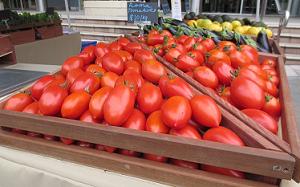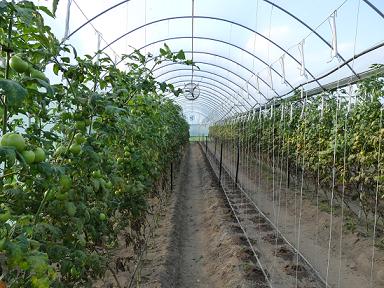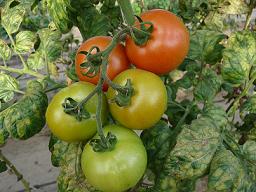
Growing Tomatoes
by Bill Pinto
THOSE living in the Northern Hemisphere are just a few days away from spring. This is the time for planting all your summer vegetables like, Tomatoes, Peppers, Eggplants, Cucumbers etc.
In this article I will share some of the most important tips I’ve learnt in growing nutrient rich and flavorsome tomatoes.

At Beulah Organics we have become highly in demand for our tomatoes. We grow mainly Roma’s and some truss varieties. For approximately 12 weeks during the summer months we produce around 200-250 kilos (440-550 lbs.) a week and all our tomatoes are pre-sold. This volume is harvested from 500 plants grown in a hothouse, which we call Igloos. It’s a structure made of wood, steel, or aluminium and covered with plastic and shade cloth on the sides. The size and complexity of the structures can be varied to suit your needs. Our hothouse is almost 1,000 sq. mtrs. (3,250 sq. ft.). The advantages of having a hothouse are many. The produce we grow inside grows much faster, produces larger and cleaner fruit, and makes it much easier to control pests. One of the biggest problems with tomatoes is caterpillars. In a hothouse we are able to keep out the butterflies, so generally we have no caterpillar problems. One disadvantage however is humidity, so it is important to have good air flow and ventilation. This is achieved by fans, vented windows, or louvers. Another advantage with hothouses is you can plant much earlier in the season. For example, in Australia our spring begins around the 1st of September so we always plant our tomatoes, peppers, cucumbers etc. in mid-August, when it is still too cold to plant outside. Most field growers have to wait till the last frost, usually around the end of September or even October. Therefore the hothouse produce is available at least six weeks before the field crops are ready; plus you have the protection from storms and strong winds etc., which can really decimate field crops, especially tomatoes. Not only does a hothouse allow your season to begin earlier, but it will also extended it longer!
In our hothouse we have tomatoes 10 months out of the year, and our structure is quite basic and without heating. If you’re growing veggies just for the family, you could build a simple structure in a day, with simple materials like timber, plastic and shade cloth for little cost. The most important aspect of building your own hothouse is to make sure your posts are grounded deep in the earth and even concreted in, otherwise strong winds can pick up the entire structure, and cause a lot of damage.

When growing tomatoes, whether in a hothouse or out in the field, always prepare your soil 6–8 weeks ahead – please see our previous article on green manure crops for nitrogen fixing. Also the soil PH should be slightly acidic, around 6–6.5 PH. I have never had to test the soil – nature always seems to get the balance just right. One thing you generally have to apply is lime, which is the white dust from crushed limestone. If you live in the Pacific Islands, coral and shells work well. The lime or shells add much needed calcium to the soil, particularly when you’re growing tomatoes. One of the most common problems with tomatoes is blossom end rot, where the fruit goes black and begins to rot on the bottom. The cause is either a lack of calcium in the soil, or the inability of the plants to uptake (absorb) the calcium in the soil. If you’re planting in virgin soil your first season’s crops should be fine, in succeeding years you will need to apply the lime at least six weeks ahead of planting.
Rock minerals are another essential input for nutritious tasty tomatoes. Our customers always tell us how sweet our tomatoes are, and that is mainly due to the minerals in the soil. People often tell us they don’t get as hungry when they eat our produce, which is also due to the mineral content. Your fruit should always be dense and heavy, which is a good sign that you have a good mineral content, and gives your tomatoes a good taste. The different varieties of tomatoes also make a difference in flavor, size, and disease resistance. Always save the seeds of your favorite variety from the largest and best fruit on the vine, allowing it to get super ripe before removing for seed saving.
There are basically two types of tomato plants – “determinate,” often called a “bush type,” and “indeterminate,” or “vining type”.
Determinate plants don’t need staking, and need no pruning, making these the generally used variety for field tomatoes. We grow the “indeterminate” type, which requires pruning. There is a little more work involved, but the rewards too are much more, and with much larger and cleaner fruit, particularly with our pruning method.
The science is simple; pruning the vine of its stems and leaves results in all the energy produced for the pruned stock going instead into the fruit! This is the most important lesson I have learnt in the years I have been growing tomatoes. The tomato plant is a rigorous grower and spends most of its nutrients, which it transforms into energy, in growing stems and leaves, not in growing its fruit! Farmers like I have for too many years spent a lot of our time and resources in growing very healthy branches and leaves, instead of large juicy tasty tomatoes!

When you prune most of the leaves off your plant, your tomatoes will grow faster, bigger and heavier. It’s normally 12 weeks (3 months) from planting a seedling to picking your first fruit. With this method you can be picking in 10–11 weeks.
A very common disease in tomatoes is fungus, like black spot etc. This problem is exacerbated when you have numerous plants side by side laden with leaves and heavy growth. With our pruning method there is much more sunlight and airflow between the plants, which helps keep them dry, and results in less humidity.
So the question is, How many leaves should we remove? When you first plant your seedling, plant it down deep, to the first little leaves. This will encourage strong root growth from the partially buried stem. As the plant begins to grow, remove every leaf up to the first flower set. You should have nothing but the trunk of the plant up to its first set of flowers. Then you can leave two leaves and remove every new leaf until you get to the next flower set. Continue this method until you reach your desired height. I generally grow my plants up a string to about 2 mtrs. (6.5 ft.) in height. I normally get 8 hands of tomato trusses (a “branch” with a cluster of fruit), and sometimes even 9 hands. I usually cut my flowers to 5 or 6 maximum per truss.
Cutting back the flowers is the same reasoning for the heavy pruning. The plant will have a lot more energy to put into a truss of five rather than a truss of 8 or 9. The result is larger, heavier, and healthier fruit. A truss of 5 large tomatoes is going to weigh a lot more than a truss of seven or eight small fruits. It’s also more appealing, more nutrient dense, and cuts back the labor for picking and packing.
There is another advantage I have discovered with this new pruning method: In the past, when my tomato trusses were coming into the final stage (where they begin to change from bright green to light green and then slowly to red, which is the stage the fruit reaches its maximum size), the fruit changes color, stops growing and starts to slowly ripen. It’s at this stage that the truss is heaviest, and to my great disappointment I would come into the hothouse each morning to see dozens and dozens of trusses torn from the stem of the plant on the ground, and because they were still green the fruit was wasted. The stem of the truss could not hold the weight of the tomatoes and would give way at its weakest point, which is where it was attached to the trunk of the plant.
But when we adopted this new pruning method I was so surprised to see what took place. God has not only placed an innate intelligence in our bodies to fight disease and keep us alive, He has also done the same in nature. Let me explain. I have been growing the same tomato variety for the last 8 years, and the trusses tearing off the trunk was my greatest problem. I was doing everything right – the plants were healthy, the fruit large. Everything would go well, until the final stage, approximately 2 weeks before picking, when I would find on the ground truss after truss, torn loose from the trunk of the plant. Our only solution at the time was to use some string and tie each truss back to the main trunk for extra support, which was very time consuming.
Then to my surprise, when I began the new pruning method, I noticed a large ring, like a muscle forming around the branch of the truss at the point where it is connected to the trunk. It makes the connection so strong that even if you try you cannot tear the branch away from the trunk! I have been using this method for 4 years now and have not had a single truss tear away from the trunk. And it’s the same variety that I have always grown! You see, God knows where its weakness is, and with the extra energy given to the plant by this new method of pruning, it forms this muscular ring around the connection between its trunk and the fruit bearing branch. Thus the load is no longer “heavy laden,” but rather the “burden is light,” and the husbandman can receive “the precious fruit.”
What beautiful object lessons we can learn from God’s creative works. When we allow Him to do a thorough pruning, we too are privileged to partake of that Divine Energy, and escape the corruption in the world, bringing forth fruit ready for the harvest, to the pleasure of the Faithful Husbandman.
Why would professed Christian Church buildings have a door for devils? And what doctrine could lead them to such a practice? Find the answers to these questions and more in this article.
Report from the Philippines
Brother Chris Sparks tells some wonderful testimonies from his stay there in the Philippines with Pastor David Sims and Brother Ray Mendiola.
What is Your Picture of a Happy Life? - Part 3
Finding true happiness in Jesus' sermon on the Mount of Blessings.
Gardening - Growing Tomatoes
In this article I will share some of the most important tips I have learnt in growing nutrient rich and flavorsome tomatoes.
Health Corner - Exercise & Brain Power
Have a bad memory? Do you have a hard time formulating words? Find out how one of God's simple remedies can improve your cognitive processes!
Think on These Things - Rightly Dividing the Word of Truth
Brethren, we must realize that there are certain sound principles of reasoning and Bible study ...
Recipe
Raquel's Apple-berry Muesli - A quick recipe for a healthy breakfast!
Seventh Day Home Church Fellowships is an association of Sabbath-keeping groups, which through web & tele-conferencing provides means for study, fellowship, and jointly organized missionary projects.
Website: www.seventhdayhomechurchfellowships.org
Email: admin@seventhdayhomechurchfellowships.org
Seventh Day Home Church Fellowships:
P.O. Box 262, Laconia, NH 03246, U.S.A.
